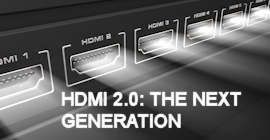Help > USB Versions Explained
USB 2, 3.0, 3.1, 3.2, and 4.0 Explained: All You Need To Know
USB technology has come a long way since this data transfer protocol was introduced as version 1.0 in 1996. USB standards and technologies are licensed and maintained by the USB Implementers Forum or USB-IF. There are currently 4 USB generations or standards, and multiple different connector types. The VERSION of USB (ie USB 2.0, or USB 3.0) does not define a connector type. It instead defines a set of data standards - normally speed protocols. A USB 2.0 cable can have a type-A, B, MicroB, or MiniB (plus other less common) connector type. The USB 2.0 standard defines the speed standard of 480Mbps.
Important Note: SOME of our USB 3.2 Gen 1 cables do not yet have the updated PVC molded ends, and are stamped "3.0" instead of the newer "3.2 Gen1". You can be assured if our website lists our products to meet USB 3.2 Gen1 (or Gen2), they have been manufactured to meet this USB standards.
The USB 1.0 standard is no longer used and supported by most computers or operating systems and was replaced 4 years later by USB 2.0. This standard is still widely used 20+ years later by nearly all computers, smart phones, and other small devices.
The USB 3.0 standard was released in 2008, but has only recently been widely adopted by nearly all computers, smart-phones, and devices. This standard has also been the most confusing standard because various revisions were introduced. USB then further confused us when they re-named certain USB 3.0 technologies to "USB 3.2" and then further added to the confusion with additional names appendices like "Gen 1", "Gen 2" or 2x1, 2x2, etc. The renaming of the USB standard has caused all sorts of confusion for consumers, especially was a cable that might have a name "USB 3", and the raw material marked "USB 3", but the cable actually adhering to a different USB 3.x standard (such as USB 3.2 Gen 1 5Gbps).
| USB Version | Original Name | Max Speed |
Common Connector Types | Release Date |
USB-IF Name | Notes |
| 1.0 | 1.5 M | A, B | 1996 | USB 1.0 | No longer supported. Some USB 2.0 technologies support this standard to be backward compatible | |
| 2.0 | 480 M | A, B, Micro-B, Mini-B | 2000 | USB 2.0 | Widely supported by nearly all computer, smart-phone, and devices. | |
| 3.0 | 5 G | A, B, Micro-B | 2008 | No longer marketed* | Now the de-facto standard for nearly all computers, smart-phones, and devices | |
| 3.1 | 5 G | A, B, Micro-B, C | 2013 | No longer marketed* | USB 3.1 continued to support 5Gbps but added the Type-C connector | |
| 3.1 Gen 1 | USB 3.1 Gen 1 | 5 G | A, B, Micro-B, C | 2013 | No longer marketed* | Re-name only. No changes were made to protocols or connector types. |
| 3.1 Gen 2 | USB 3.1 Gen 2 | 10 G | A, B, Micro-B, C | 2013 | No longer marketed* | Gen 2 increased the speed capabilities to 20Gbps |
| 3.2 Gen 1 (1x1) | 5 G | A, B, Micro-B, C | 2017 | SuperSpeed USB 5 Gbps | PD (Power delivery) specification added allowing up to 2.5 watts of power. | |
| 3.2 Gen 2 (2x1) | 10 G | A, B, Micro-B, C | 2017 | SuperSpeed USB 10 Gbps | Introduced "SuperSpeed+" with speeds up to 10Gbps | |
| 3.2 Gen 2x2 | USB 3.2 | 20 G | C Only | 2017 | SuperSpeed USB 20 Gbps | Support for "Dual-lane data operations" and only available with the Type-C connector |
| 4.0 (2x2) | 20 G | C Only | 2019 | USB4 20Gbps | The USB4 standard is based on the Thunderbolt 3 protocol developed and licensed by Intel | |
| 4.0 (3x2) | 40 G | C Only | 2019 | USB4 40Gbps | Dual-lane data support added, doubling the USB4 2x2 specifications |
* - USB-IF no longer recommends adopters and manufacturers market this USB version, but instead market them using the USB 3.2 Gen 1x1, 2x1, or 2x2 naming convension to avoid confusion.






